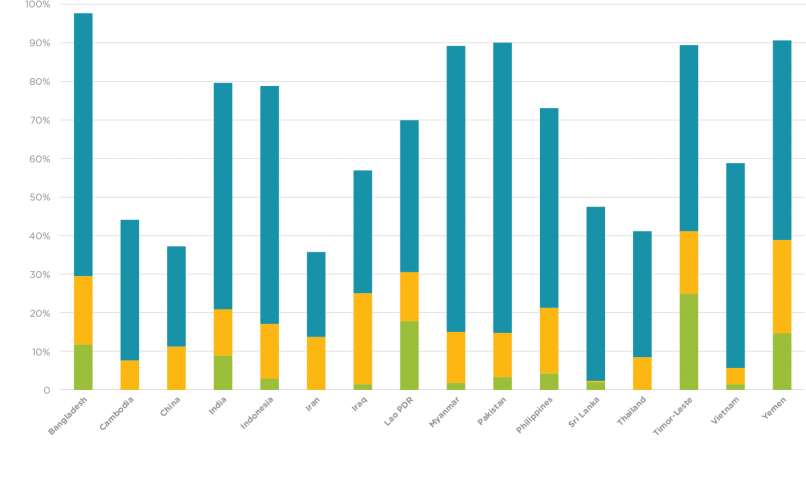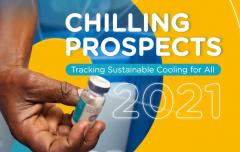Global access to cooling: Regional trends
Key messages
- Cooling access gaps for the rural and urban poor at highest risk grew in each region compared to the previous year.
- Those at medium risk, in the lower-middle income category, increased in Africa, decreased in Asia and the Middle East, and remained the same in Latin America and the Caribbean.
Africa
In Africa, the analysis covers 31 countries that experience high temperatures and are identified as being high-impact for access to sustainable cooling. Across the region, a combined 389 million are at highest risk among the rural and urban poor. The number living in poor rural areas at high risk due to a lack of access to cooling total approximately 174 million people, accounting for 39 percent of the total rural population of Africa and 21 percent of the continent’s total population.
Compared to 2020, an increase of 11.4 million was observed, which was a larger increase than in previous years. This is in part due to the poverty impact of the COVID-19 pandemic, but also continues a trend that began in early 2020. The gap has continued to widen since 2018, having grown 11.6 percent from 156 to 174 million people and accounting for 49 percent of the total number of rural poor globally.
Figure 1.10: Trends in populations at risk across 31 high-impact countries in Africa (millions)
Table 1.5: Trends across 31 high-impact countries in Africa

In African cities, 215 million people are among the urban poor at highest risk from a lack of access to cooling, an increase of 8.0 million. These rapidly expanding cities in high-impact countries are seeing increasingly concentrated cooling access risks, with over 70 percent of the urban populations of 16 countries at high risk: Angola, Benin, Burkina Faso, Chad, Congo, Guinea-Bissau, Liberia, Malawi, Mali, Mozambique, Niger, Nigeria, South Sudan, Sudan, Togo and Uganda.
The lower-middle income group, who will soon be able to purchase the most affordable air conditioner or refrigerator on the market, also continues to grow in Africa, increasing by 43 million people since 2018. Between these three groups, approximately 776 million people across the 31 high-impact countries in Africa, or 93 percent of their total population, face cooling access challenges.
Asia and the Middle East
In Asia and the Middle East, significant growth in the rural poor and lower-middle income populations was observed in 2021, while the proportion of the urban poor population continued its more consistent growth. The number of people living in poor rural areas in high-impact countries in Asia and the Middle East increased by approximately 18 million people between 2020 and 2021. The most significant increases were observed in India and Bangladesh, where energy access gains have been moderated by persistent levels of extreme poverty that were exacerbated by the COVID-19 pandemic. In India, an increase of 13 percent, or 13.9 million rural poor at risk was observed, from 107.4 million in 2020 to 121.3 million in 2021. In Bangladesh, the number of rural poor increased by 2 million people or 12 percent, from 17.3 million to 19.3 million. In addition, Iran, Iraq, Pakistan and Sri Lanka also saw increases of 10 percent or higher.
Between 2020 and 2021, the number of urban poor at risk from a lack of access to cooling in Asia and the Middle East grew by 10 million people, from 462 to 472 million people across 16 high-impact countries for access to sustainable cooling. Urban populations at risk are most significant by volume in India, China, Indonesia, Bangladesh and Pakistan, though growth in this category in 2021 was relatively uniform, between 1 and 4 percent per country.
Overall, the populations at highest risk in Asia and the Middle East continue to grow, increasing 28 million to 645 million in 2021 from 617 million in 2020, itself an increase of 13 million from 604 million in 2018.
Figure 1.11: Trends in populations at risk across 16 high-impact countries in Asia and the Middle East (millions)
The cooling needs of Asia and the Middle East continue to grow, as shown by increases in the numbers of rural poor, (18.9 million), urban poor, (6 million), and the lower-middle income population, (164 million). The lower-middle income population had been decreasing in recent years, and this change in trend can be explained by the increase in the number of people who live on less than USD 10.01 per day as a direct result of the COVID-19 pandemic. In 2021, more than 75 percent of the total population of seven countries in Asia and the Middle East are at high or medium risk: Bangladesh, India, Indonesia, Myanmar, Pakistan, Timor-Leste and Yemen.
Table 1.6: Trends across 16 high-impact countries in Asia and the Middle East

Figure 1.12: Share of rural poor, urban poor, and lower-middle income populations in select high-risk countries

Latin America and the Caribbean
In Latin America and the Caribbean, the number of those at highest risk in six high-impact countries grew slightly from 47.6 million people in 2020 to 48.8 million people in 2021. Of those at highest risk, the vast majority are the urban poor, which increased by 500,000 people compared to the previous year. Within the region, the most significant growth in the urban poor category was observed in Brazil (299,000 people) and Bolivia (55,000 people). Among the rural poor, each country experienced growth between 12 and 14 percent, increasing the total number of people living in rural settings who are at high risk of a lack of access to cooling by approximately 700,000.
Among the six high-impact countries identified in the region, Paraguay and the Dominican Republic saw the largest declines in their lower-middle income populations, by 12 and 5 percent respectively, though the size of the middle-income population in each country remained relatively stable. The Dominican Republic has been working with the United for Efficiency Initiative on a National Cooling Strategy that addresses many key issues related to access to affordable and sustainable cooling solutions for these two groups, including transforming the markets for refrigerators and making efficient air conditioners more affordable.
Figure 1.13: Trends in populations at risk across 6 high-impact countries in Latin America and the Caribbean (millions)
Table 1.7: Trends across 6 high-impact countries in Latin America and the Caribbean






